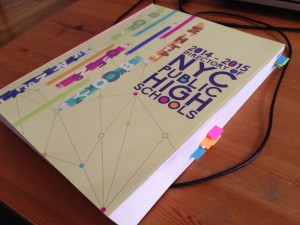2014
not just tea at the airport
maura @ 2:21 pm
Fair warning: this post will be extremely boring to most humans. It may perhaps be slightly interesting to folks who are parents of children under the age of 18 and/or live in NYC, but YMMV.
The kid is in 8th grade this year, which means that we as a family are thoroughly immersed in the high school application process. Recently I’ve been surprised at how much less stressful I’m finding this process than I expected, especially based on our middle school application experience. But I also feel like it’s taken up lots of headspace, room that I can’t really afford to allot to it right now. So this post is the HS purge, writing it out to free up those braincycles.
Over the course of I don’t know how long because I wasn’t really paying attention since it didn’t really affect me — maybe 10 years? — the NYC public high schools have transformed from (I think?) mostly zoned, mostly biggish, neighborhood schools into schools that are more or less available for any NYC kid to apply to and range in size from 300 to 5000 students. There are definitely some advantages to this. Some of the schools are truly excellent, some have a specific curricular focus for the non-required courses, and some have pretty small class sizes (20-25 students). On the other hand, applying to a small focused school is essentially asking a 13 yr old to decide what they want to be when they grow up, which for many kids is much much too early. On the third hand, going to a science-focused high school doesn’t mean that you can’t go to an arts-focused college, or the reverse, so lighten up! (I tell myself.)
Applying to public high school in NYC can be complex and labor-intensive. The numbers give you a sense of it: across the 5 boroughs there are 400 high schools, with 700 programs (some schools have several different curricular programs and you apply to the program rather than the school), and each program uses one of 8 (eight!) different admissions processes. The book that I call the Giant Book of High Schools that got sent home at the end of last year is 3″ thick:

Like with middle schools, students and parents are encouraged to go to the open house or tour for each school they’re interested in. For us that is shaping up to be 9 schools, maybe 10. We are not considering anything that’s more than a 45-ish minute commute, which keeps us in Brooklyn and Manhattan.
The biggest division is what are called the specialized high schools — there are 8 of them spread throughout the city, and admission is via one standardized test called the SHSAT. High-stakes testing is stinky, though I admit it makes the process more straightforward. Basically any kid who wants to go to a specialized school takes the test, which is held on one weekend in the fall, chooses which of the 8 schools they’re willing to go to and lists them on the test form. The kid with the highest score gets matched with the school she ranked #1, the kid with the second highest score with her #1 choice, and so on down the list until all of the seats in each of the 8 schools are filled. We’re touring 2 of these schools, and have also signed the kid up for the test prep afterschool course at his middle school. I’m not a big fan of test prep, but a combination of factors wore me down: most kids seem to take it, the SHSAT is a strange, one-off test that’s not like any tests the kids have taken before or will take again, and the course (which is really just doing practice tests with a teacher) seems like it’ll reduce anxiety about the process.
The rest (and vast majority) of the schools are the “unspecialized” schools, and they use any one of the remaining 7 admissions methods. Some of them have geographic preferences, and will take kids in the school’s neighborhood or borough first. Some have grade or standardized test score requirements. Some require their own test, or an interview, or a portfolio, or an essay, or a letter of recommendation from a teacher. The schools with performing arts programs often require an audition (that’s not for us). Whatever the admissions method, the end result is the same: there’s a form that comes home from middle school that we fill out by ranking *all* of the schools he’d be willing to go to, then we send the form back in and the DOE feeds it all into a special machine which spits out the high school matches. There are 12 slots on the form, and it’s recommended that you list no less than 6 schools because while there is a round 2, it’s much more challenging to get into schools during round 2 as most of the schools have already filled their seats.
We’re looking at 8 unspecialized schools. Three are easy: take the tour, rank the school on the form (because the kid meets their admissions requirements, which are published in the Giant Book, and the school can look at the DOE system to see his grades and test scores). Two each require you to bring your 7th grade report card and take a specific test for just that school, and one of those also requires an interview (if your test score is high enough). One requires an “admissions activity” — we don’t know what it entails because it isn’t live on the school’s website yet. One requires a short essay as well as a copy of your 7th grade report card. One requires a portfolio of work from 7th grade and an interview. (Is that all 8? I think so.)
I fully acknowledge the advantage that our privilege affords us in this process. We are fortunate enough to have the time and energy to devote to researching schools, booking tours and tests (some of which fill up almost as soon as they’re listed on the schools’ websites), paying for a SHSAT prep course, and schlepping around to all of this stuff, most of which happens between 8am and 5pm on weekdays. It’s true that there are many schools that don’t require anything other than listing the school as one of the 12 schools on the form, provided that your child meets the grade/test score requirements. But the system definitely privileges those families with both the resources to spend on the admissions process as well as those with children in high-performing elementary and middle schools (which, of course, is another privilege).
While I can’t say I’m in love with this system, it’s the system we have. For us we’re using a google doc and calendar to keep track of things, and since my brain likes learning about and keeping track of minutia I’ll admit to a certain amount of satisfaction that we have gotten everything scheduled for the fall. But I will still be happy when it’s all over. And wow, that’s over 1,100 words — hope that works to clear out my brain!




